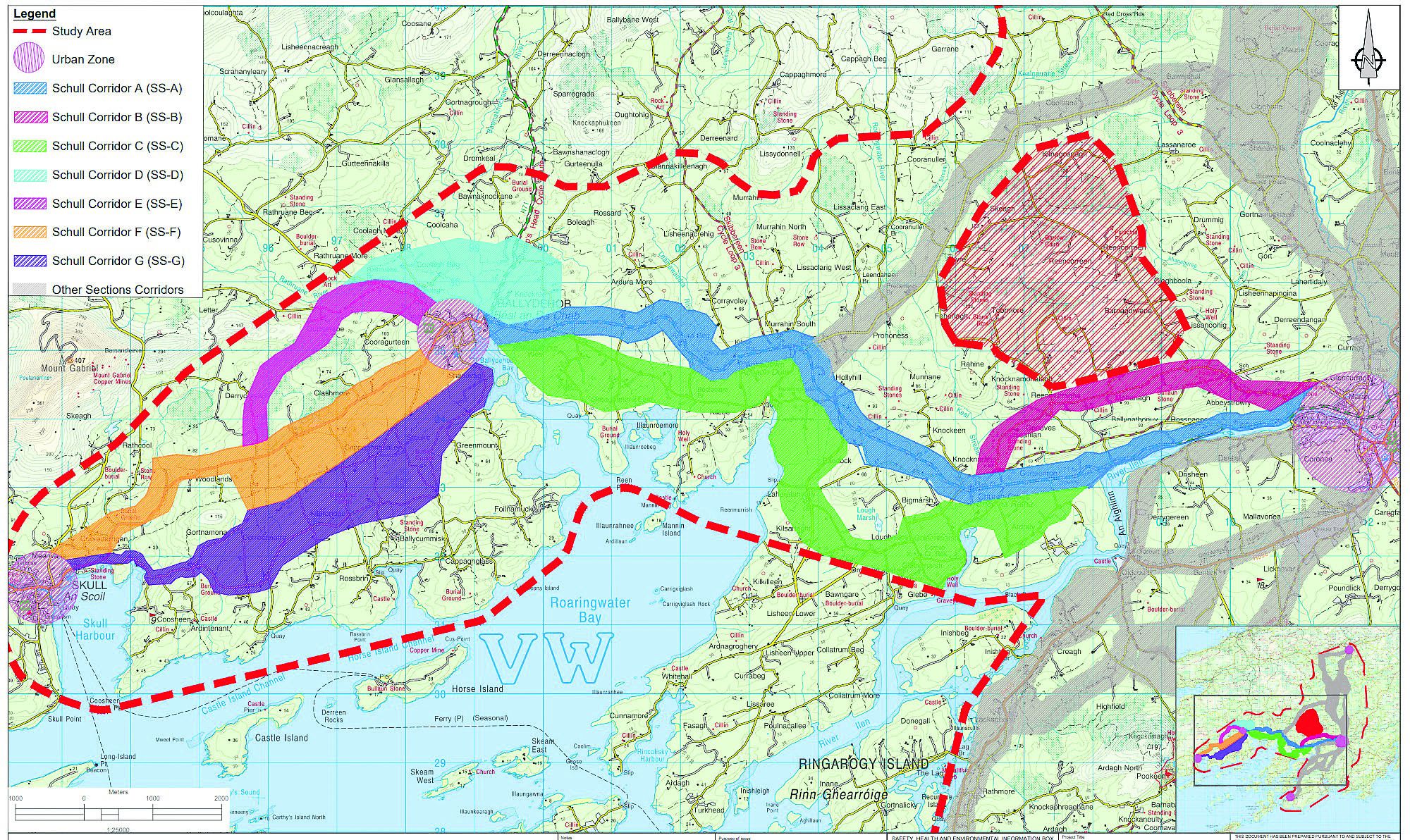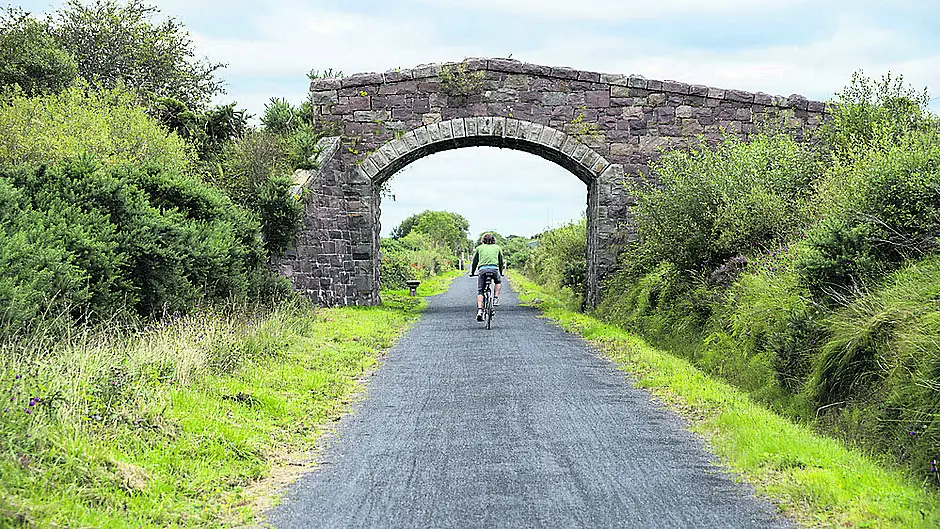SPECIAL REPORT: A GAME CHANGER FOR WEST CORK TOURISM

Star editor looks at the progress of the West Cork Greenway project which has identified several possible route ‘corridors’ starting in Skibbereen
A NUMBER of route options for the planned greenways which will traverse West Cork were put on display recently in hotels in Schull and Skibbereen.
The West Cork Greenway is currently at Phase 2 of the process, with a projected completion date of Phase 4 by 2028. The route itself is not expected to be completed by 2028, but at that point planning applications will be made, and the project managers Roughan & O’Donovan and Aecom will have carried out their briefs.
The final phases – 5 and 6 – will be subject to planning approval and funding for the construction and implementation of the routes.
Overall, the target is for West Cork to have a greenway network to rival those which have brought huge economic benefit to the likes of Co Waterford and Co Mayo, and several other areas of the country, completed – or almost completed – by the end of this decade.
The routes are being planned in response to a huge demand in both domestic and international tourism for ‘experience’ holidays – where families and individuals can cycle carefree along designated off-road routes, enjoying Ireland at its best, and safely.
Anyone who has travelled the greenways in other parts of the country have had an almost universally positive reaction to this relatively new type of holiday.
Whether for weekends away with the girls, a five-day tour of a region with smallies or siblings, it really is hard to beat a safe and convenient cycling trip, at a time when health and fitness are to the forefront of so many people’s minds.
The greenways in other regions have brought huge benefits to the local economies. Villages like Kilmeaden and Kilmacthomas in Waterford have suddenly found themselves the focus of massive tourist attention, and the nearby gardens at Mount Congreve are popular with the passing trade from greenway cyclists who love stopping there for a coffee or to enjoy the gorgeous horitulture on display.
Likewise, the 49km greenway from Westport to Achill has seen a host of little businesses springing up along the route, from art galleries to tiny off-road cafés and sculpture experiences. It really is a wonderful way to view the country and now, with the advent of electric bikes and bikes with buggies for smallies attached, there really is no excuse for anyone not to take part.
Of course, several other counties have now developed, or are developing, greenway routes, including Westmeath, Limerick and Kerry.
The West Cork Greenway is an initiative of Transport Infrastructure Ireland, Cork County Council, the National Roads Office (Cork) and project managers Roughan & O’Donovan and designers Aecom.
It’s not just for tourists, either. Local commuters can use the off-road routes to safety travel to work, school, or for shopping at a nearby town or village, giving them the added benefit of helping to reduce carbon emissions by switching from cars to pedal or electric bicycles for short journeys.
There are already plans in train for the Cork to Kinsale and Cork to Bandon greenway routes, meaning West Cork could eventually become a veritable cyclists’ haven, given given the already established artisan food industry and stunning vistas in the region.
The plan for the southerly part of West Cork is to have three possible routes – Skibbereen to Schull, Skibbereen to Drimoleague and Schull to Baltimore.
It’s possible that all three routes may get the go-ahead, or there may be be just two, or even just one.
Currently, the Skibbereen to Drimoleague route looks like the least tricky, given the flatter terrain in the region.
For example, earlier plans to run the Baltimore route to Lough Hyne proved too difficult, due to the hilly terrain, but the route will still be within cycling distance for those cyclists who want to ‘spur’ off the main route and visit the pretty nature reserve.
During the first phase of investigations, the team held public consultations in January to outline the general areas being surveyed for the likely routes. This time around, during the second phase, the project managers showed the public maps containing the more concentrated route ‘corridor’ options – ie, not the exact planned routes, but areas which had been narrowed down since the first phase of investigations.
There are three general route options on the Skibbereen to Ballydehob section – one which runs near the coast, a second option which would largely follow the N71 road and a third which may take in an area north of the N71 before reconnecting close to the main artery.
On the Ballydehob to Schull route, the areas being surveyed are similar – south of the village of Ballydehob, north of it, and one option that is close to the main road.
 The route corridor options for the Skibbereen to Schull section. These will be narrowed down in the next phase.
The route corridor options for the Skibbereen to Schull section. These will be narrowed down in the next phase.
The Skibbereen to Baltimore options are currently quite varied. They range from a route that runs similar in direction to the flow of the Ilen river, a second one that loosely follows the R595 main road to Baltimore, and a third option that runs closer to Lough Hyne, before looping west towards Baltimore.
 The route corridor options for the Skibbereen to Baltimore section. These will be narrowed down in the next phase.
The route corridor options for the Skibbereen to Baltimore section. These will be narrowed down in the next phase.
The route from Skibbereen to Drimoleague will likely encompass one of three options – either skirting close to Caheragh village, and then running close to the main Bantry to Drimoleague road; or veering right of Caheragh through flatlands into Drimoleague, or a third option, which would see the initial section of the route passing close to the hospital in Skibbereen and passing through Bauravilla, before connecting back with the second route into Drimoleague.
 The route corridor options for the Skibbereen to Drimoleague section. These will be narrowed down in the next phase.
The route corridor options for the Skibbereen to Drimoleague section. These will be narrowed down in the next phase.
Representatives of Cork County Council at the public consultation told The Southern Star that there maybe also be an option to connect the Drimoleague route to the Ballydehob route, via a corridor to the north west of Skibbereen.
Any landowners in the vicinity of the suggested corridors should now make contact with the Council, if they haven’t already done so, they added.
While the final greenway route, or routes, may be some time off, the project is now beginning its engagements with affected landowners.
It is expected those in the suggested corridors will be invited to share their thoughts on the preferred routes and the relevant factors for consideration at the start of next year.
The project should then move into Phase 3 in 2026, when design will start on the final routes and environmental impact studies will also begin.
 At the second public consulatation meeting for the West Cork Greenway Skibbereen Schull sections were members of the project Jane Anderson (AECOM) and Rachel Heaphy (ROD) at Schull Harbour Hotel. (Photo: Carlos Benlayo)
At the second public consulatation meeting for the West Cork Greenway Skibbereen Schull sections were members of the project Jane Anderson (AECOM) and Rachel Heaphy (ROD) at Schull Harbour Hotel. (Photo: Carlos Benlayo)
The last phase of planning will involve more consultations on the design, and a move towards applying for planning, all of which would bring the project up to 2028, when funding will then be sought for the construction.
All going well, West Cork could be in a position to offer tourists some stunning cycle trails, with associated facilities and new businesses, by 2030.
It would be a game-changer, not just for tourism, but for the local economy too, and add a very special offering for visitors to the south west.









